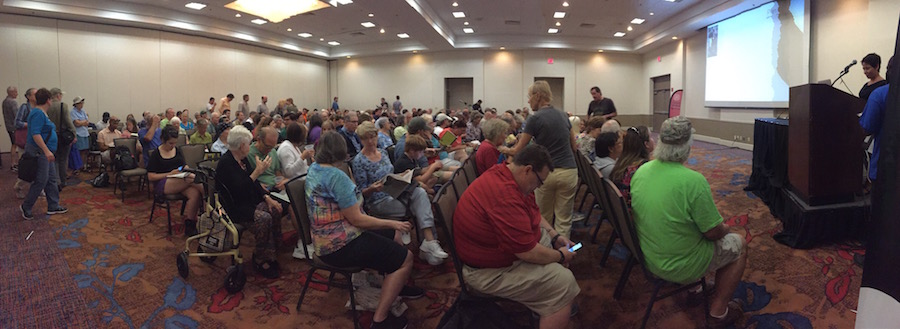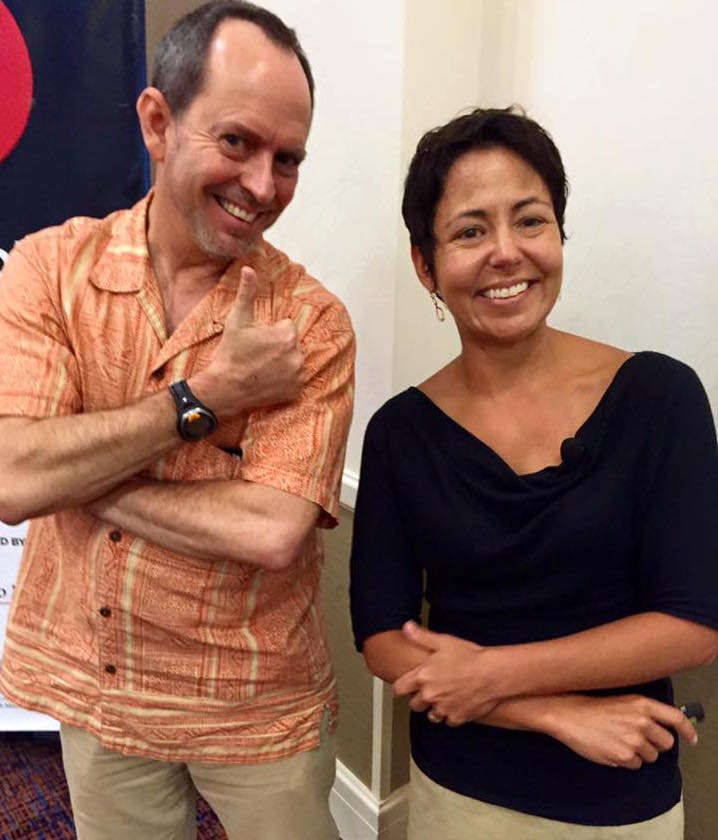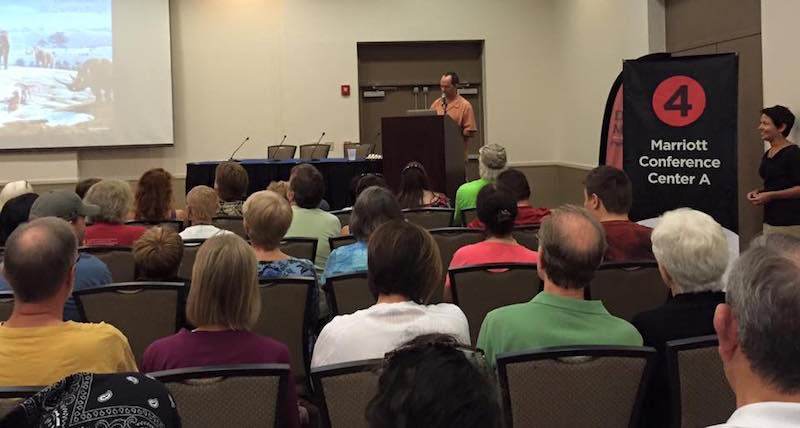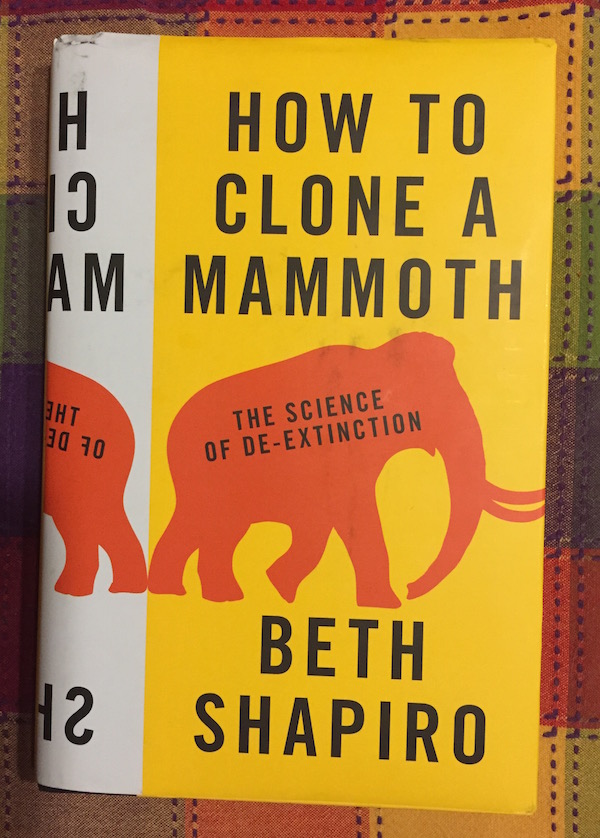For the past ten years, Labor Day weekend in my adopted home town of Decatur, Georgia means the Decatur Book Festival takes over the downtown area. This is always a good thing, as attested by the 70-80,000 people and more than 500 authors who attend it each year, as well as the tens of thousands of books sold, making it the largest independent book festival in the U.S. But this year I thought of a way to make it a little more exciting: Bringing back some recently departed Pleistocene megafauna to the area.
 A small sample of book lovers attending the 2015 Decatur Book Festival, walking up and down Clairemont Road in lovely downtown Decatur on a beautiful day. The only thing that would improve this picture is a rampaging herd of mammoths, perhaps accompanied by a pack of dire wolves. (Photograph by Anthony Martin.)
A small sample of book lovers attending the 2015 Decatur Book Festival, walking up and down Clairemont Road in lovely downtown Decatur on a beautiful day. The only thing that would improve this picture is a rampaging herd of mammoths, perhaps accompanied by a pack of dire wolves. (Photograph by Anthony Martin.)
As a “local boy done good,” I’ve been lucky enough to participate directly in the festival the past few years as an author and introducer of authors. In 2012, I was part of a panel discussion with authors Maryn McKenna and Dr. Holly Tucker about science authors using social media. In 2013, I was invited by the Atlanta Writers Club to present on my then-new book Life Traces of the Georgia Coast, and in another session introduced Brian Switek, there to talk about his book My Beloved Brontosaurus. Last year, I was delighted to be invited as one of the featured authors in the Science Track of the festival for my book Dinosaurs Without Bones.
With the planning of the 2015 Decatur Book Festival, and a new book in the works but nowhere near published, I figured my role in it this year would be as a spectator and probable book purchaser. So I was very pleased when festival organizers, in cooperation with the Atlanta Science Tavern, asked me to introduce one of the featured authors in the Science Track, Dr. Beth Shapiro, an invitation I readily accepted. Her new book, How to Clone a Mammoth: The Science of De-Extinction, promised to be one of the more exciting titles showcased in the Science Track. Of course, I was also happy that my trip to this event involved only a 15-minute walk from home.
To start prepare for introducing Dr. Shapiro at the festival, I bought her book and read it beforehand, cover-to-cover. I’m not going to review it here (that’s partially covered in my introduction anyway), but the following book trailer, narrated by Shapiro, succinctly tells its story while using nicely rendered watercolors to illustrate its main points.
This is how science-book trailers should be done: Short and simply told, using lots of pretty pictures, but injected with enough intrigue to make you want to learn more about the topic. The video is narrated by Beth Shapiro and the artwork by Peter Durand, and is available for free download from Vimeo at this link.
After reading Dr. Shapiro’s book, I started writing my introduction for her, using some of the main ideas posed in the book and some biographical information. Yet somehow I knew that to just do that could be really boring. I also knew that because this was a book festival and I was a book author, it would be totally appropriate for me to actually write something original and read it to this literary-loving audience. This was not the time to “wing it” with a stumbling, impromptu little speech that just said, “The book’s great, she’s great, get the book!”
So this is when I took a page (or two) out of my most recent book (Dinosaurs Without Bones) and created a scenario to draw in and involve the audience more directly. In Dinosaurs Without Bones, I open the book with a detailed description of dinosaurs interacting with one another and making traces (tracks, burrows, nests, and more) in a given hour back in the Cretaceous Period. This time, though, I imagined a re-booted Pleistocene megafauna cavorting in downtown Decatur immediately after Shapiro’s talk (described below), then followed it with laudatory comments about the book and its author. Once written, I edited the rough draft, edited it again, and a third time, then rehearsed and timed the introduction four times. I only had about 3 minutes, and the final version came out to 3:30 minutes: Close enough.
I figured her talk, scheduled for 1:15 p.m. Sunday (September 6) at the Marriott Conference Center in downtown Decatur, would be packed, and it was. By about 1:05 p.m., the room was already nearly filled, and by the time I started my introduction, about 400 people were in the room, with many standing in the back and on the sides. This turned out to be the best attended of all Science Track talks at the festival, which was not surprising considering the interesting subject, lots of advance press about her book, and Dr. Shapiro’s engaging presentation style.
 A panorama of the crowd as Beth Shapiro (far right) sets up her laptop at the podium, just before my introduction. The few empty seats you see in this photo were filled within minutes. (Photo by Anthony Martin.)
A panorama of the crowd as Beth Shapiro (far right) sets up her laptop at the podium, just before my introduction. The few empty seats you see in this photo were filled within minutes. (Photo by Anthony Martin.)
I also met Dr. Shapiro for the first time about 10 minutes before my introduction, where we had a lively and fun exchange (including the coincidence that we had both attended the University of Georgia, albeit at separate times). We even had time to pose for a picture, taken by my wife, Ruth Schowalter.
 Just in case you were confused, that’s me on the left, and Beth Shapiro on the right. (Photo by Ruth Schowalter.)
Just in case you were confused, that’s me on the left, and Beth Shapiro on the right. (Photo by Ruth Schowalter.)
What’s charming about the Decatur Book Festival is that even the introducers are introduced, so I had to wait while the room captain (Anthony) read a brief biography about me, then I jumped up on stage for my introduction. All I’ll say is that it went very well, and I’m even more pleased to report that Shapiro’s talk was excellent, serving as a model for effective science communication.
 Me on stage introducing Beth Shapiro (far right), with a large happy, enthusiastic crowd listening, and there for a science book. Did I already say how much I love the Decatur Book Festival? (Photo by Ruth Schowalter.)
Me on stage introducing Beth Shapiro (far right), with a large happy, enthusiastic crowd listening, and there for a science book. Did I already say how much I love the Decatur Book Festival? (Photo by Ruth Schowalter.)
My introduction follows in its entirety, and you’ll just have to think about how it would sound while reading it out loud, and with much dramatic emphasis.
Imagine exiting this building, but you have to pause for a moment because a herd of mammoths is strolling down Clairemont Road. On the Decatur town square, you move warily around a giant ground sloth tearing apart a Southern magnolia, and likewise give wide berth to several wooly rhinoceroses grazing by the gazebo. A pack of dire wolves dash by, chasing down a soon-to-be locally extinct coyote. However, you are amused when, in what looks like an act of vengeance, a giant bison crashes through the front door of Ted’s Montana Grill. Suddenly, a sunny day turns dark, and you look up to see a vast, dark cloud, from which a gentle rain falls. Only the “cloud” is composed of a billion passenger pigeons, and that’s not rain you’re feeling.
The animals just mentioned were all here, but separated from us by the geologically brief time of 11,000 years, or for passenger pigeons, only a hundred years. In Dr. Beth Shapiro’s brilliant new book, How To Clone a Mammoth: The Science of De-Extinction, she highlights our close temporal proximity to these extinct animals, while also exploring the feasibility of bringing them back alive, to the here and now.
Part lesson in the once-separate realms of genetics and paleontology, part wistful elegy to these recently departed animals, and all-good storytelling, How to Clone a Mammoth is a book that provokes weighty thoughts about improving our future by reliving the past. These animals or their proxies may be just what we need to repair environments devoid of long-gone keystone species. Forget Jurassic World with its super-sized mosasaurs, constipated dinosaurs, and improbable heels: We want “Pleistocene Park.” And our perfect guide for learning how to create that park is Dr. Shapiro.
As an Associate Professor of Ecology and Evolutionary Biology at the University of California-Santa Cruz, Dr. Shapiro studies de-extinction, a word that originated in science fiction, but thanks to her efforts and those of her colleagues, is now evolving into science fact. I also envy her UC-Santa Cruz students, who surely gain new and life-changing insights in her classes, benefiting directly from her field experiences in Siberia and laboratory expertise.
How to Clone a Mammoth is a provocative book, literally, as it provokes many questions. For instance, can we really clone a mammoth? How do we reconstruct their genome and those of other long-extinct animals? Once made, how does a “de-extincted” species become a self-sustaining population? How does this population fit into a modern community of microbes, plants, and animals? And, most importantly of all, should we try to bring back extinct animals, even those that only recently departed this earth? In other words, when creating a “Pleistocene Park,” will we make something more akin to Stephen King’s Pet Cemetery?
To answer all of those questions and more, we are very lucky to have Dr. Shapiro here today to talk about her book, How to Clone a Mammoth: The Science of De-Extinction. Please join me in welcoming Dr. Beth Shapiro.
So if you were there at the Decatur Book Festival, I hope you enjoyed it, and especially the Science Track. Oh, and by the way, y’all really need to get (and read) Beth Shapiro’s book, How to Clone a Mammoth: The Science of De-Extinction (2015, Princeton University Press).
 My copy of the book, personally autographed by Beth Shapiro. No, I’m not going to sell it to you: Get your own copy. (Photo by Anthony Martin.)
My copy of the book, personally autographed by Beth Shapiro. No, I’m not going to sell it to you: Get your own copy. (Photo by Anthony Martin.)
